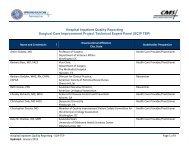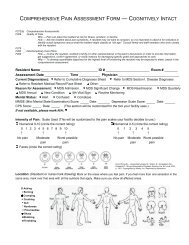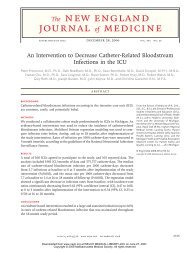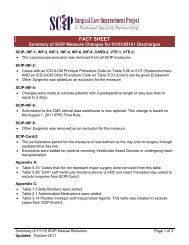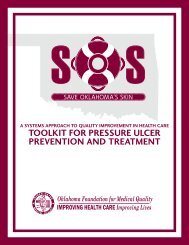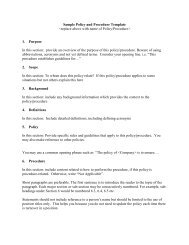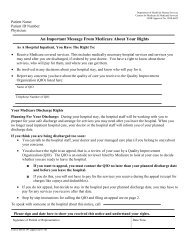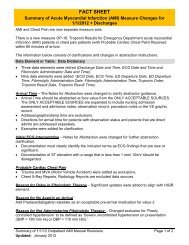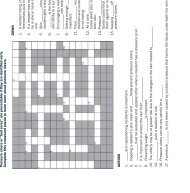Resource Guide: Pressure Ulcer Prevention and ... - HealthInsight
Resource Guide: Pressure Ulcer Prevention and ... - HealthInsight
Resource Guide: Pressure Ulcer Prevention and ... - HealthInsight
You also want an ePaper? Increase the reach of your titles
YUMPU automatically turns print PDFs into web optimized ePapers that Google loves.
DEFINITIONS<br />
<strong>Pressure</strong> <strong>Ulcer</strong>- A pressure ulcer is localized injury to the skin <strong>and</strong>/or underlying tissue usually<br />
over a bony prominence, as a result of pressure, or pressure in combination with shear <strong>and</strong>/or<br />
friction<br />
Suspected Deep Tissue Injury- Purple or maroon area of discolored intact skin due to damage<br />
of underlying soft tissue damage. The area may be preceded by tissue that is painful, firm,<br />
mushy, boggy, warmer or cooler as compared to adjacent tissue.<br />
Stage 1 <strong>Pressure</strong> <strong>Ulcer</strong>- An observable, pressure-related alteration of intact skin, whose<br />
indicators as compared to an adjacent or opposite area on the body may include changes in one<br />
or more of the following perimeters: skin temperature (warmth or coolness); tissue consistency<br />
(firm or boggy); sensation (pain, itching) <strong>and</strong>/or a defined area of persistent redness in lightly<br />
pigmented skin, where as is darker skin tones, the ulcer may appear with persistent red, blue, or<br />
purple hues.<br />
Stage 2 <strong>Pressure</strong> <strong>Ulcer</strong>- Partial thickness loss of dermis presenting as a shallow open ulcer with<br />
a red pink wound bed, without slough. May also present as an intact or open/ruptured serumfilled<br />
blister.<br />
Stage 3 <strong>Pressure</strong> <strong>Ulcer</strong>-Full thickness tissue loss. Subcutaneous fat may be visible but bone,<br />
tendon or muscle is not exposed. Slough may be present but does not obscure the depth of tissue<br />
loss. May include undermining <strong>and</strong> tunneling.<br />
Stage 4 <strong>Pressure</strong> <strong>Ulcer</strong>-Full thickness tissue loss with exposed bone, tendon or muscle. Slough<br />
or eschar may be present on some parts of the wound bed. Often include undermining <strong>and</strong><br />
tunneling.<br />
Unstageable <strong>Pressure</strong> <strong>Ulcer</strong>- Full thickness tissue loss in which the base of the ulcer is covered<br />
by slough (yellow, tan, gray, green or brown) <strong>and</strong>/or eschar (tan, brown or black) in the wound<br />
bed. Until enough slough <strong>and</strong>/or eschar is removed to expose the base of the wound, the true<br />
depth, <strong>and</strong> therefore stage, cannot be determined. Stable (dry, adherent, intact without erythema<br />
or fluctuance) eschar on the heels serves as “the body’s natural (biological) cover” <strong>and</strong> should<br />
not be removed. (NPUAP 2007)<br />
Healed <strong>Pressure</strong> <strong>Ulcer</strong>- Completely closed, fully epithelialized, covered completely with<br />
epithelial tissue, or resurfaced with new skin, even if the area continues to have some surface<br />
discoloration.<br />
Eschar-dead or devitalized tissue that is hard or soft in texture; usually black, brown, or tan in<br />
color, <strong>and</strong> may appear scab-like. Necrotic tissue <strong>and</strong> eschar are usually firmly adherent to the<br />
base of the wound <strong>and</strong> often the sides/edges of the wound.<br />
Exudate-any fluid that has been force out of the tissues or its capillaries because of<br />
inflammation or injury.<br />
6




